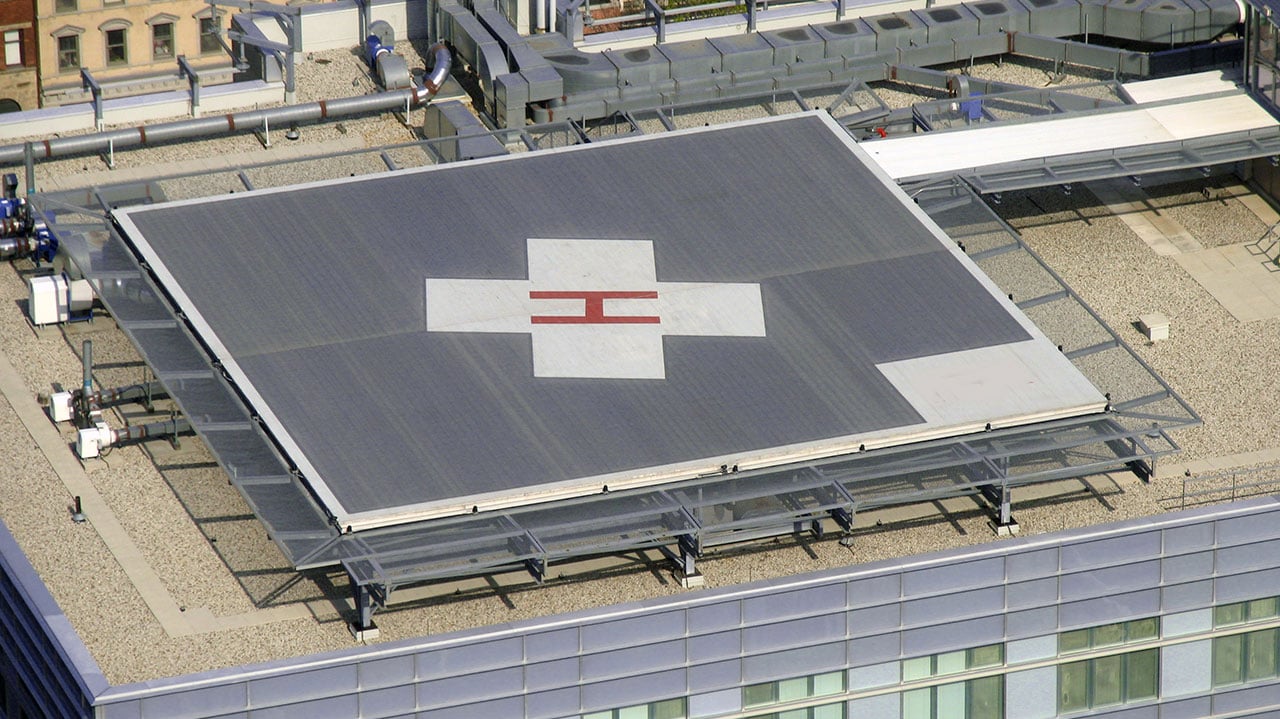Critical infrastructure must always be protected – and hospitals are critical infrastructure. Hospitals don’t have downtime – they can’t have downtime – because they literally represent life support systems for the people inside them. Any loss of power or operations can put peoples’ lives at risk.
With that in mind, the most critical part of any building is its roof. Therefore, the hospital roofing is the most critical part of a critical building. Hospitals often use their roofing to house electrical and HVAC equipment, among other things. If any of these items fail, they can have wide-ranging consequences and inflict lasting damage on the building.
Common Hospital Roofing Equipment
Hospitals are like normal commercial buildings in certain respects. These buildings all have pipes, cables, and HVAC on their roofs, for example. In hospitals, however, familiar-looking equipment may have a more critical role – and there might be equipment that you don’t often find in other places.
- HVAC
Hospitals often have vast HVAC systems designed to make sure that every room within the hospital is at an ideal temperature – warm enough for patient comfort, but not so warm as to promote bacterial growth.
- Backup generators
Hospitals require multiple backup generators in order to assume the entire electrical load of these massive buildings if the grid goes down. Many hospitals in hurricane-prone areas have resorted to placing generators on the roof in order to prevent them from flooding.
- Solar Panels
To get past the problems posed by diesel generators, an increasing number of hospitals are instead relying on solar for both backup and continuous power generation. Solar panels can dramatically slash energy costs for hospitals when in use. When combined with a battery system, hospitals can store electricity for emergency situations.
- Helipad
Medevac is a life-saving service that involves transporting severely ill or injured patients by helicopter directly to a hospital facility. Building regulations often permit hospitals to place their helipads on rooftops, especially in urban environments where no other landing platform is available.
What does all of this equipment have in common? It’s heavy, requires relatively frequent maintenance, and must be protected by rooftop supports.
Why Do Hospitals Need Roofing Supports?
Clearly, a roof is important on any building, but hospital roofing integrity has an extra dimension of importance. Any equipment that causes damage or penetrations to the roofing surface can cause cascading effects that do far more than cause maintenance issues.
First, there are leaks. It’s bad news if any building’s roof leaks, but hospitals are full of sensitive equipment and sick people. If water damage shorts out critical life support and diagnostic equipment, the hospital will suffer as it incurs repair and replacement costs – and patients will suffer if they can’t get care. There’s also mold to consider. Leaks promote mold, and a hospital may house dozens of sick or immunocompromised patients. Allowing mold to enter the building would be a great detriment to their quality of life.
When heavy hospital equipment is allowed to rest directly on a rooftop, it impinges upon the relatively fragile roof membrane – potentially causing leaks. Leaks, however, are only one of a number of bad outcomes. Backup generators are fueled by diesel, which is flammable. In the unlikely event that a backup generator catches fire, keeping it directly on the roof surface gives the fire a way to spread. While solar panel fires are rare, they’ve also been known to happen.
Helipads are their own special risk center. There’s no centralized body in charge of helipad design, so in theory there’s nothing preventing a hospital designating a landing zone directly on the roof surface. This would definitely cause damage, however, as would unobstructed foot traffic directly on the roof surface itself. There’s also a huge danger around slips, trips, and falls.
Make Your Hospital (and Staff) Safer with Rooftop Supports
At PHP Systems/Design, we’re experienced when it comes to creating rooftop support structures for hospitals. We can provide customized non-penetrating supports for heavy equipment, solar panels, pipes, and cable runs, distributing the weight of this equipment and keeping it off your roof. We can also provide walkways, crossovers, and stairways that help protect your maintenance crews, aircrew, and EMTs. Here at PHP, we believe in doing everything we can to help make hospitals safer.




